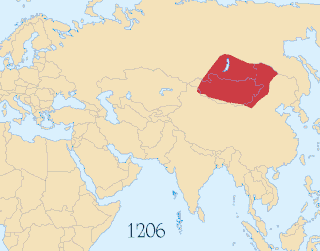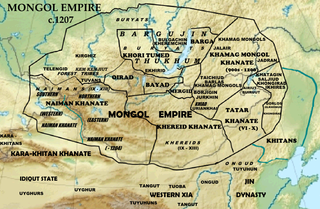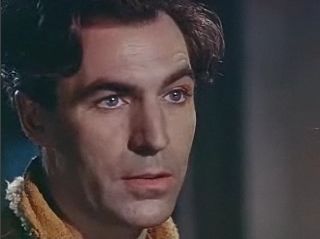
The Golden Horde, self-designated as Ulug Ulus, was originally a Mongol and later Turkicized khanate established in the 13th century and originating as the northwestern sector of the Mongol Empire. With the division of the Mongol Empire after 1259, it became a functionally separate khanate. It is also known as the Kipchak Khanate or the Ulus of Jochi, and replaced the earlier, less organized Cuman–Kipchak confederation.

The Mongol Empire of the 13th and 14th centuries was the largest contiguous empire in history. Originating in present-day Mongolia in East Asia, the Mongol Empire at its height stretched from the Sea of Japan to parts of Eastern Europe, extending northward into parts of the Arctic; eastward and southward into parts of the Indian subcontinent, mounted invasions of Southeast Asia, and conquered the Iranian Plateau; and reached westward as far as the Levant and the Carpathian Mountains.

The Pax Mongolica, less often known as Pax Tatarica, is a historiographical term modeled after the original phrase Pax Romana which describes the stabilizing effects of the conquests of the Mongol Empire on the social, cultural and economic life of the inhabitants of the vast Eurasian territory that the Mongols conquered in the 13th and 14th centuries. The term is used to describe the eased communication and commerce the unified administration helped to create and the period of relative peace that followed the Mongols' vast and violent conquests.

A Borjigin is a member of the Mongol sub-clan that started with Bodonchar Munkhag of the Kiyat clan. Yesugei's descendants were thus said to be Kiyat-Borjigin. The senior Borjigids provided ruling princes for Mongolia and Inner Mongolia until the 20th century. The clan formed the ruling class among the Mongols and some other peoples of Central Asia and Eastern Europe. Today, the Borjigid are found in most of Mongolia, Inner Mongolia and Xinjiang, and genetic research has shown that descent from Genghis Khan and Timur is common throughout Central Asia and other regions.

Ann Marie Blyth is an American retired actress and singer. She began her acting career on Broadway in Watch on the Rhine (1941–42), and was nominated for an Academy Award for Best Supporting Actress for her performance as Veda in the 1945 Michael Curtiz film Mildred Pierce. Her other notable film roles include Brute Force (1947), Mr. Peabody and the Mermaid (1948), Once More, My Darling (1949), The World in His Arms (1952), All the Brothers Were Valiant (1953), Rose Marie (1954), The Student Prince (1954), Kismet (1955), and The Helen Morgan Story (1957).

From the 1220s into the 1240s, the Mongols conquered the Turkic states of Volga Bulgaria, Cumania and Iranian state of Alania, and various principalities in Eastern Europe. Following this, they began their invasion into Central Europe by launching a two-pronged invasion of then-fragmented Poland, culminating in the Battle of Legnica, and the Kingdom of Hungary, culminating in the Battle of Mohi. Invasions were also launched into the Caucasus against the Kingdom of Georgia, the Chechens, the Ingush, and Circassia though they failed to fully subjugate the latter. More invasions were launched in Southeast Europe against Bulgaria, Croatia, and the Latin Empire. The operations were planned by General Subutai (1175–1248) and commanded by Batu Khan and Kadan, two grandsons of Genghis Khan. Their conquests integrated much of Eastern European territory into the empire of the Golden Horde. Warring European princes realized they had to cooperate in the face of a Mongol invasion, so local wars and conflicts were suspended in parts of central Europe, only to be resumed after the Mongols had withdrawn. After the initial invasions, subsequent raids and punitive expeditions continued into the late 13th century.
Nogai, or Noğay was a general and kingmaker of the Golden Horde. His great grandfather was Jochi, son of Genghis Khan.

Berke Khan was a grandson of Genghis Khan from his son Jochi and a Mongol military commander and ruler of the Golden Horde, a division of the Mongol Empire, who effectively consolidated the power of the Blue Horde and White Horde from 1257 to 1266. He succeeded his brother Batu Khan of the Blue Horde (West), and was responsible for the first official establishment of Islam in a khanate of the Mongol Empire. Following the Sack of Baghdad by Hulagu Khan, his cousin and head of the Mongol Ilkhanate based in Persia, he allied with the Egyptian Mamluks against Hulagu. Berke also supported Ariq Böke against Kublai in the Toluid Civil War, but did not intervene militarily in the war because he was occupied in his own war against Hulagu and the Ilkhanate.

David Farrar was an English stage and film actor.

Tokhta was one of Tartar Rulers of the Golden Horde from 1291 to 1312. He was a son of Khan Mengu-Timur and a great-grandson of Batu Khan.

Starting in the 1240s, the Mongols made repeated invasions of Syria or attempts thereof. Most failed, but they did have some success in 1260 and 1300, capturing Aleppo and Damascus and destroying the Ayyubid dynasty. The Mongols were forced to retreat within months each time by other forces in the area, primarily the Egyptian Mamluks. The post-1260 conflict has been described as the Mamluk–Ilkhanid War.
Descent from Genghis Khan in East Asia is well documented by Chinese sources. His descent in West Asia and Europe was documented through the 14th century, in texts written by Rashid-al-Din Hamadani and other Muslim historians. With the advent of genealogical DNA testing, a larger and broader circle of people have begun to claim descent from Genghis Khan owing to dubious and imprecise haplogroup identifications. However, while many of Genghis Khan's agnates' resting places are known, none of their remains have been tested to prove or disprove these theories and debate continues.

As of 2020, Islam in Mongolia is practiced by approximately 5.4% of the population. It is practised by the ethnic Kazakhs of Bayan-Ölgii Province and Khovd Province aimag in western Mongolia. In addition, a number of small Kazakh communities can be found in various cities and towns spread throughout the country. Islam is also practiced by the smaller communities of Khotons and Uyghurs.

Kublai Khan, also known by his temple name as the Emperor Shizu of Yuan and his regnal name Setsen Khan, was the founder and first emperor of the Mongol-led Yuan dynasty of China. He proclaimed the dynastic name "Great Yuan" in 1271, and ruled Yuan China until his death in 1294.
The Wings of the Golden Horde were subdivisions of the Golden Horde in the 13th to 15th centuries CE. Jochi, the eldest son of the Mongol Empire founder Genghis Khan, had several sons who inherited Jochi's dominions as fiefs under the rule of two of the brothers, Batu Khan and the elder Orda Khan who agreed that Batu enjoyed primacy as the supreme khan of the Golden Horde.

The Mongols were highly tolerant of most religions during the early Mongol Empire, and typically sponsored several at the same time. At the time of Genghis Khan in the 13th century, virtually every religion had found converts, from Buddhism to Eastern Christianity and Manichaeanism to Islam. To avoid strife, Genghis Khan set up an institution that ensured complete religious freedom, though he himself was a Tengrist. Under his administration, all religious leaders were exempt from taxation, and from public service. Mongol emperors were known for organizing competitions of religious debates among clerics, and these would draw large audiences.

The Prince Who Was a Thief is a 1951 American adventure film directed by Rudolph Mate and starring Tony Curtis and Piper Laurie. A technicolor swashbuckler, it was the first film Curtis featured in as a star. It was produced and distributed by Universal Pictures.

Target Zero is a 1955 American war and drama film directed by Harmon Jones and written by James Warner Bellah and Sam Rolfe.The film stars Richard Conte, Peggie Castle, Charles Bronson, Richard Wyler, L. Q. Jones and Chuck Connors. The film was released and published by Warner Bros. on November 15, 1955.

The Timurid conquests and invasions started in the seventh decade of the 14th century with Timur's control over Chagatai Khanate and ended at the start of the 15th century with the death of Timur. Due to the sheer scale of Timur's wars, and the fact that he was generally undefeated in battle, he has been regarded as one of the most successful military commanders of all time. These wars resulted in the supremacy of Timur over Central Asia, Persia, the Caucasus, the Levant, and parts of South Asia and Eastern Europe, and also the formation of the short-lived Timurid Empire.
















